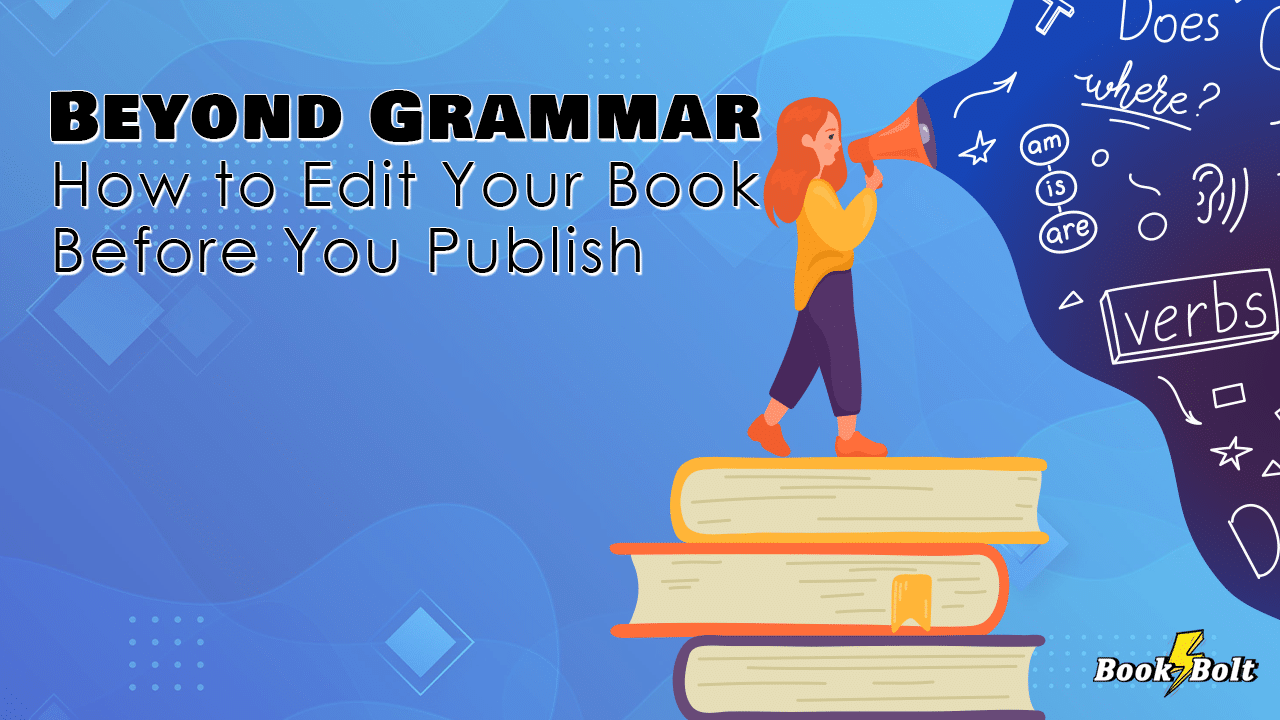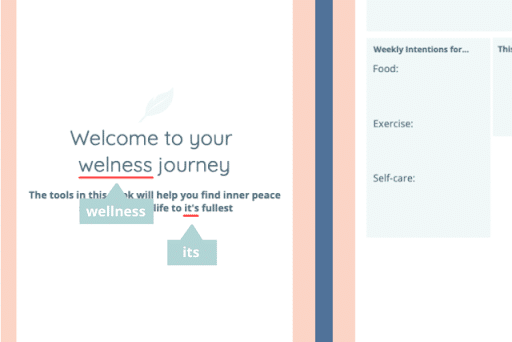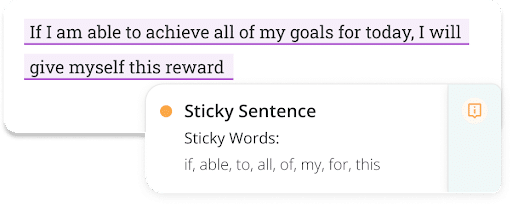
To many people, editing is something that happens in a publishing house. You need formal training to edit writing, right?
Actually, you don’t. With some insider tips, you can make your writing clearer, more accurate, and more engaging for your readers.
While low-content books don’t contain many words, they do need to be well designed and easy to use. And that means the words you do write need to be as clear as possible.
Do I Need to Edit My Low-Content Book?
Yes! Even though you haven’t written many words, you still need to edit. This will be a quicker job than editing a novel—made even quicker if you use a grammar checker—but there are still some key steps you should take before you publish.
In this article, we’ll walk you through the 6 steps to editing your low-content book.
1. Fix Your Grammar and Spelling
Typos make your reader lose trust in your book. If you spell wellness wrong on the first page of your wellness journal, they can’t trust you with their wellbeing, can they?
At the very least, you need to remove any typos or grammar errors from your low-content book before you publish.
You can use a grammar checker to make this easier. It will highlight any wrong spellings, incorrect comma placements, confused words (like affect and effect), and hundreds of other errors you might miss on your own.
If you want to do it yourself, here are some things you should look for:
- Incorrect spellings (missing letters, swapped letters)
- Confused words like its and it’s
- Missing commas between independent clauses and coordinating conjunctions
- Commas missing after introductory phrases
- Misplaced apostrophes
- Hyphens after adverbs ending in -ly (remove them)
- Ellipses with more than three periods
And that’s just the start. Eagle-eyed readers will spot these mistakes, which can damage your credibility.
Fortunately, there are tons of resources on the internet to help you here. Look up a list of grammar rules—or use a checker. They’re often free, and they remember these things for you.
How to Edit Different Types of Low-Content Books
If you’re creating a weekly meal planner, or any other book that only uses one or two-word headings, this may be the only editing step you need. If your book is a little more complex, for example a guided journal or tracker, there are a few more stages to consider.
Low-content doesn’t mean you can’t deal with complex concepts. But you do need to convey them to your readers as simply—and in as few words—as possible.
Luckily, improving how readable your sentences are often makes them shorter, too.
Fixing your spelling is the bare minimum. Take your book from brilliant to bestselling by improving the clarity and efficiency of your words with the next few steps.
2. Cut Unnecessary Words
You want to create your low-content book fast. But the first idea you think of isn’t always the best. That’s where editing comes in.
People want simplicity. When deciding whether to buy your book, they want to see how it will answer their needs as quickly as possible. Your book’s design plays a large role in this—but so do your word choices.
Imagine you’ve written this section heading in your weekly planner template:
If I am able to achieve all of my goals for today, I will give myself this reward…
Sure, that makes sense. But there are a lot of unnecessary words in there like ‘able to’, ‘all of my’, ‘for’, ‘will give myself this’. These are “glue” words—words that help the sentence make sense, but don’t add to its meaning.
Remove as many glue words as possible from your headings and sentences to streamline your reader’s experience. If you need help working out which words are glue words, a good editing software will let you know.
Here’s that original sentence, simplified:
My reward for achieving today’s goals is…
This sentence takes up less space, and it’s clear from the second word what the section is for.
3. Watch Out for Repeats
If your book has the same page repeated throughout, of course you’re going to have repeated words in there. But repeating a word too many times on one page can be distracting, or signal that you’re including unnecessary sentences.
Check out these puzzle instructions:
First, consider which grid has the fewest blank squares. Then, consider which numbers are missing and try to fill in at least one of the squares.
When you repeat words, they start to lose their meaning. And when you have so few words on the page to start with, they easily become distracting.
When you find repeats, ask yourself if the repeated word is the best fit for the sentence, or if you’ve just used it because it was top of mind. In this example, we can replace the first ‘consider’ with ‘find’ for a clearer sentence.
Repeats can also show you where you could structure your page more effectively.
Check out these three headings:
My exercise intention for this week is:
My food intention for this week is:
My self-care intention for this week is:
That’s a lot of intentions. Why not group them together, like this?:
Weekly Intentions:
Exercise:
Food:
Self-Care:
This helps readers see what the section is for quickly without having to read through lots of text. Let’s take a look at what that does to our book’s formatting in Book Bolt:
Much clearer and simpler.
4. Write Benefits-Led Copy With Action Verbs
Verbs drive action. Using powerful verbs in your low-content book helps readers see what your product does at a glance.
When you hide your verbs, you take strong verbs and turn them into nouns. For example, instead of saying ‘decide’, you might say ‘make a decision’.
Let’s stick with our journal example. Here are some hidden verbs you may find (and their strong counterparts):
- Make a transformation → transform
- Find a solution → solve
- Make a resolution → resolve
- Make progression → progress
- Set an intention → intend
Strong verbs are shorter, punchier, and more inspiring. Check your headings, introduction, and your KDP description for hidden verbs to make your product more appealing to buyers.
5. Inspire Reader Action with Active Voice
Low-content books ask their readers to take action by filling them in. If you don’t convince them to use your product, they’re unlikely to repurchase or check out your other products.
Whether you’re writing a puzzle book, journal, planner, or recipe book, you need to explain how to use each page effectively. This may be indirectly through headings or questions, or directly with puzzle instructions.
Take a look at these puzzle instructions:
The puzzle will be solved when all 20 of the anagrams are found.
Solve the puzzle by finding all 20 anagrams.
While the first instruction feels hypothetical, the second example includes the reader in the sentence. This is called writing in the active voice.
Writing that drives action is almost always active. In passive writing, like in the first example, the subject of the sentence is acted upon rather than acting itself.
In low-content books, the subject should usually be the reader (either “I” or “You”). When you write in passive voice, you put the reader second, or remove them from the sentence entirely. By using active language, you inspire them to take action.
Here’s another example. In a habit tracker, your reader wants help to achieve their goals.
Here are two headings you could use:
How will this be achieved?
This phrasing may make readers think “achieved by who?” Whereas if we write:
How will you achieve this?
It’s clear that they need to write what they will do to succeed.
Keep your reader front and center by writing in the active voice. If you’re not sure if your writing is active or passive, check who is completing the action in the sentence. If it isn’t clear, rephrase to make your reader the actor.
6. Optimize Your KDP Descriptions
As well as your book itself, you should also check your KDP descriptions for errors and overly complex language. Look out for vague language like “really” or “very” in your descriptions. These words usually indicate that you could use a stronger adjective.
So instead of saying that your puzzle book is “really fun for kids”, think of a specific benefit you can use instead, like “screen-free entertainment”.
Your description should inspire people to buy your product. To do this, lead with the benefits your reader will see rather than the features you offer.
Benefit-led sales copy rarely uses the passive voice. Start your key selling posts with action verbs like “engage”, “learn”, “transform”, and “organize”. Instead of ‘The weekly tracker allows healthy habits to be created’ (created by who?), write ‘Create healthy habits with the weekly tracker’.
Finally, look for repeated words in your description too. When you repeat descriptive words like ‘inspiring’ or ‘powerful’, you weaken them. Your most repeated words should be your keywords—though make sure you’re not just using keywords for the sake of it. Focus on what the reader will get from your book first and add keywords where they fit naturally.
Publish Successful Low-Content Books
Publishing low content books via KDP is a quick way to earn passive income—if you do it right.
Depending on the type of book you’re hoping to publish, editing should only take you five to thirty minutes. Spending just a little extra time editing the words in your book will help you create a robust product and a customer base that keeps coming back.


